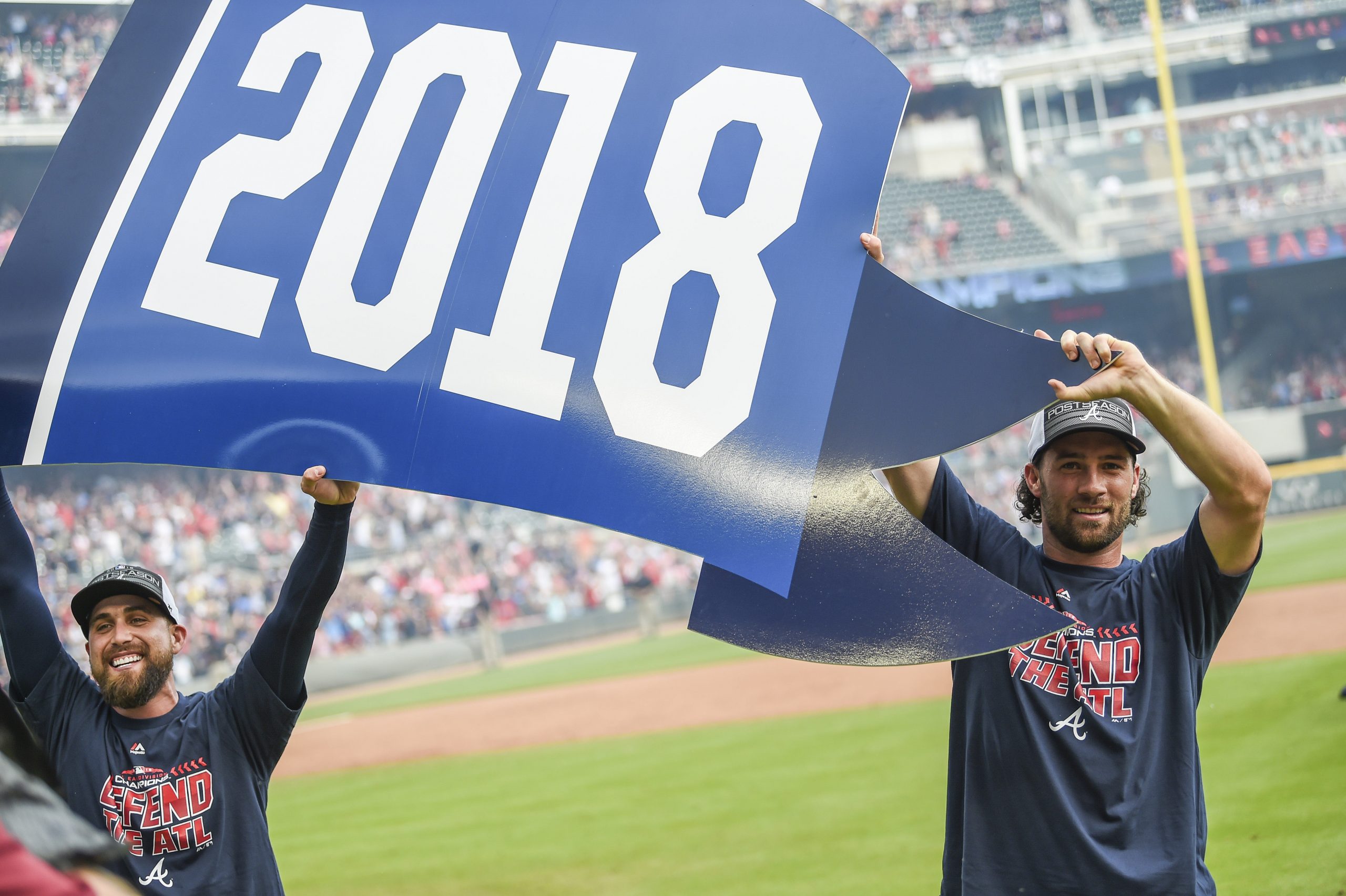The Atlanta Braves are National League Division Champs.
Let that sit in, Braves fans.
This team. Or, as fans have said over-and-over this season, this team. They are 2018 Division Champions. Regardless of how the playoffs go, this season is a success that seemed as improbable as any division title for the franchise since 1991. Oh, it’s true that this team was supposed to be better than they were in 2017. Young pups were more experienced, stronger, and expected to improve compared to last year. Maybe they could be so good that a .500 record shouldn’t be too surprising. They might even play meaningful baseball in September as a Wild Card contender.
But a division title? That was supposed to belong to the Washington Nationals, who were gunning to finally put it together in what was likely to be Bryce Harper’s swan song in our nation’s capital. Pre-season articles didn’t talked about if the Nationals would win the East. They focused on the fact that just winning the East wasn’t enough. And even if they stumbled or a collection of aliens stole Harper and Company’s baseball skills, there were the Mets behind Jacob DeGrom and Noah Syndergaard along with a plethora of veteran bats. Surely they would win the East if Harper’s mojo was gone.
But that didn’t happen. Instead, it was two squads who were expected to be stuck in another year of rebuilding – the aforementioned Braves and the Philadelphia Phillies. The two teams would battle throughout the summer as the Nationals traded off spare parts and the Mets found a way to turn a likely Cy Young winner into a pitcher with a potential losing record. The only time that has ever happened was in 2003 when Eric Gagne finished with a record of 2-3. He did save 55 games, though.
How in the world did we get here? How did the Braves become contenders when they were supposed to be a 75-win team? Well, it’s a long story so strap in.
Someone had to go.
It was September 22, 2014. A toxic situation had boiled over. When the 2014 All-Star Break arrived, the Braves were locked in a dead heat on top of the NL East. A few days into the second half, they fell into second place. But that was just the beginning of a collapse that saw the Braves win just 27 of their final 67 games to close out the schedule. Eliminated from playoff contention and thoroughly embarrassed by the Mets over a weekend sweep in which they were outscored 19-4, the Braves informed General Manager Frank Wren that his services were no longer required.
Wren had been former GM John Schuerholz’s hand-picked successor after the 2007 season. Under Wren, the team went to the playoffs three times with five winning seasons in Wren’s seven years. But beyond the results was a relationship that was, in a word, unhealthy. Wren’s micromanaging style rubbed many long-time Braves coaches the wrong way, including most notably Hall of Fame manager Bobby Cox. According to Chipper Jones’ memoir, “Ballplayer,” Cox was ready to quit the Braves during spring training before Schuerholz stepped in to mend fences. Cox’s replacement, Fredi Gonzalez, had been essentially chosen much like Wren himself – as a hand-picked successor. Wren and Gonzalez were never on the same page. Wren built a team that swung for the fences while Gonzalez yearned for a club that would be aggressive on the bases. Someone had to go.
It was Wren.
The farm system was shockingly thin at the time of Wren’s dismissal. The 2014 Braves were young and built around a homegrown nucleus of Evan Gattis, Freddie Freeman, Tommy La Stella, Andrelton Simmons, and Jason Heyward in the lineup. The pitching staff had a homegrown feel as well with Julio Teheran, Alex Wood, and Mike Minor anchoring it while Craig Kimbrel and Luis Avilan were primary arms out of the pen. Many of these players were drafted or signed or at least matured while Wren was the GM. However, the farm system was reduced to Lucas Sims, Cristhian Bethancourt, and Jose Peraza as the “stars” of the system. To be fair, young players like Ozzie Albies, Johan Camargo, and Ronald Acuña Jr. were just beginning their professional careers.
A three-man team was put together consisting of Schuerholz, Cox, and John Hart to find the Braves’ new general manager. For fans of The Office, you might have a vision of Gabe, Jim, and Toby interviewing several rather awful candidates. But from the start, the belief was that Assistant GM John Coppolella would be heavily involved in whatever decision was made. As a result, it seemed less like a search and more like an effort to put together a framework which heavily involved Coppolella and Hart, who Schuerholz brought in the previous winter without consulting Wren.
It was outside-the-box for sure. Coppolella and Hart essentially worked as Co-General Managers. Coppolella handled much of the effort to get deals from their infancy to maturity while Hart, who was consulted throughout the process, would sign off. It was a smart idea as it allowed Hart to avoid the high-stress rigors of being the point guy on everything while it gave Coppolella great on-the-job training. Further, as Coppolella was being groomed to take over, Hart would take the blunt of criticism for what promised to be a painful rebuild. That left Coppolella largely shielded from the onslaught of doubters.
Both individuals would be lauded for their accomplishments. Both would see their time with the Braves cut short by scandal.
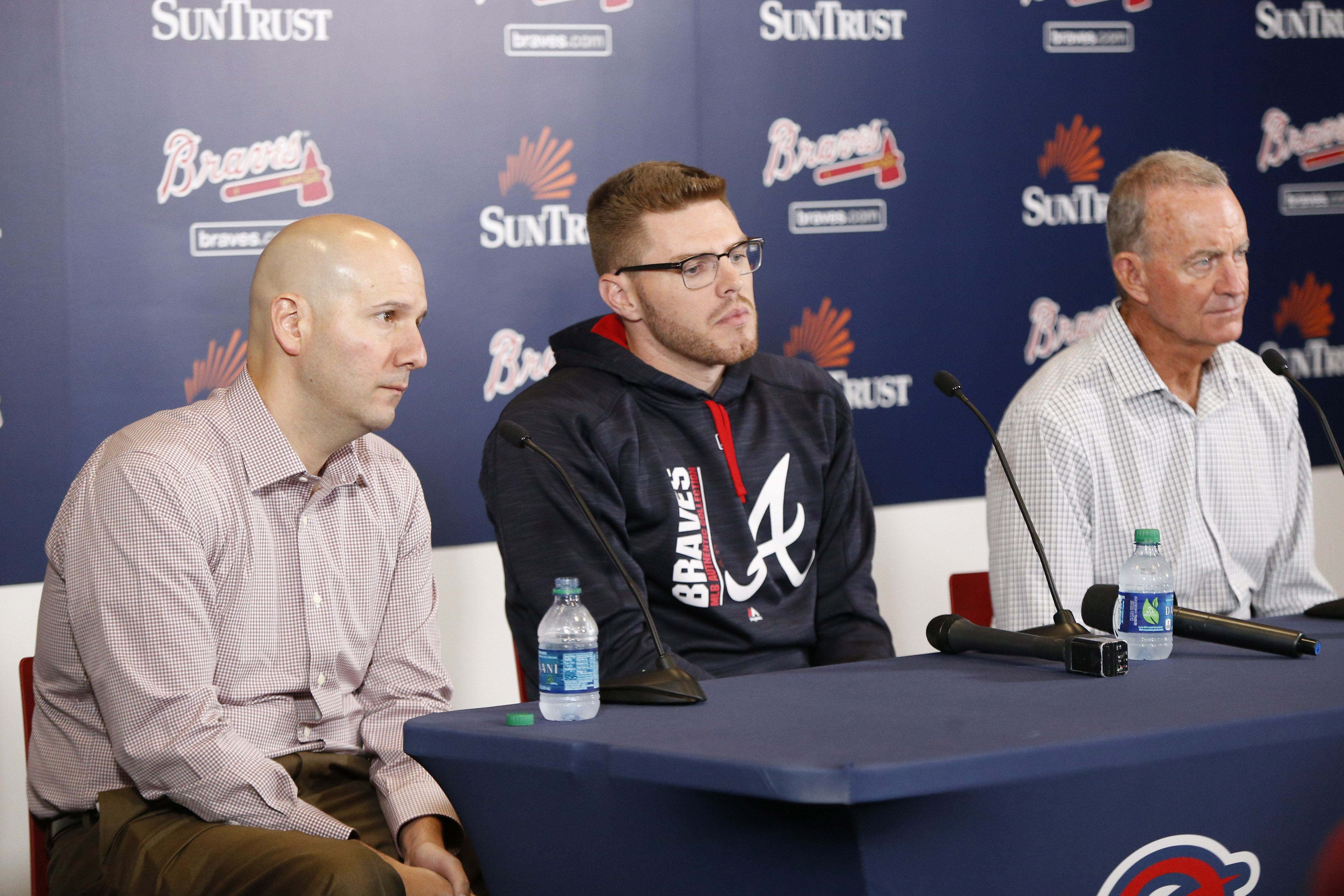
“It’s not like I’m breaking up the ’27 Yankees.”
At first, the Atlanta Braves tried to avoid the word “rebuild” as if it was a curse word. Rather, the Braves under Hart were looking to retool. It was merely semantics and public relations. Retooling sounded better as the team’s new ballpark was being built in Cobb County, north of Atlanta. The project was unpopular at the time with many people in Atlanta complaining of the move to the suburbs especially with a ballpark that was still relatively young in Turner Field.
The first winter under Hart/Coppolella was ambitious. Atlanta traded away Evan Gattis, Tommy La Stella, Justin Upton, and Jason Heyward – half of their typical lineup from 2014. They also got rid of role-players like David Carpenter, Anthony Varvaro, Jordan Walden, David Hale, and Chasen Shreve. Nearly every day, the Braves were pulling off a trade or bringing in a veteran to fill-in for a roster very much in flux. The haul that first winter included Mike Foltynewicz, Arodys Vizcaino, and Shelby Miller. But the biggest punch to the gut came just hours before opening day when the Braves traded the best closer in baseball, Craig Kimbrel, to the Padres. The money saved in this deal, which included the final three years of Melvin Upton Jr.’s $75 million contract, would be important later.
But nearly every one of the trades were criticized by segments of the fan base and even the media. Some pointed out that the 2013 Braves won the NL East. Why not truly retool and go for a ring with Heyward and the good Upton? Hart fired back, “It’s not like I’m breaking up the ’27 Yankees.” And it was a fair response. After all, the team failed to compete the previous season. The Braves also didn’t want to lose Heyward and the good Upton to free agency and only receive draft pick compensation.
Like I said, the Braves did add to the roster beyond the trades. Most of the deals they gave out were of the one-year or minor league variety, but they did sign new closer Jason Grilli to a two-year contract and shockingly gave outfielder Nick Markakis a four-year deal. Many were critical of the signing – even before it was announced that the former Oriole would undergo neck surgery shortly after signing his contract. Why sign a complimentary player for four years on the onset of a rebuild, many asked.
The Braves won their first five games of 2015, but quickly faded. They would go on to lose 95 games, the most loses by the franchise since losing 97 in 1990. Fill-ins like A.J. Pierzynski, Cameron Maybin, and a journeyman Cuban named Adonis Garcia helped, but the team was terrible while going through a franchise-record 60 players.
Hart and his prodigy, Coppolella, continued to remake the team, including trading Chris Johnson for Nick Swisher and Michael Bourn, but it would be two trades that would define the season. The first came on June 20. The 33-34 Diamondbacks were looking to jump-start their season and their GM, Dave Stewart, saw an opportunity to shed dead salary in the hope of re-purposing the money for better production. In exchange for utility infielder Phil Gosselin, Stewart sent Bronson Arroyo – or, to be blunt, his contract that still had $10 million on it. The Braves had the payroll space to make such a move because of the earlier Kimbrel/Upton trade. To give the Braves a reason to take on the salary, Stewart also sent the 16th overall pick of the 2014 draft. That player’s name was Touki Toussaint. We’ll get back to him in a bit, I’m sure.
The other trade showed Coppolella’s weakness. It also took the Braves down a rabbit hole. When the young executive was convinced a move would pay off, he sported a tendency to go running into walls to make the deal happen. A star in Cuba, Hector Olivera defected around the time that Frank Wren was fired. After a few months, he was declared a free agent and the Braves tried to sign him. However, the Dodgers offered about twice as much and Olivera took their $62.5 million offer. Dejected, Coppolella never let up on his dream of Olivera finally being the guy to truly replace Chipper Jones at third base. Slowed by visa issues, Olivera was also dealing with rust from a lack of competitive baseball for much of the previous three years and a hamstring injury. In the end, he would never play in the majors for the Dodgers.
Instead, the Braves acquired him in a much-criticized deal that sent Alex Wood, Jose Peraza, and others to the Dodgers. It didn’t take long for problems to develop with the 30-year-old Olivera. A second basemen in Cuba, he never looked all that comfortable at third base and once the winter leagues opened, Olivera was moved to left field. So much for the idea that he would replace Chipper Jones.
However, he could still be a hitter. Olivera came to camp in 2016 and impressed many on-lookers with a .393 average in 61 at-bats. But Olivera’s career hit a snag when, a week into the season, he was arrested for assaulting his girlfriend at the hotel the Braves were staying at during a series in Washington. He would be convicted of that charge in September of 2016, but by then, some things had happened with Olivera. He was suspended for 82 games and then dealt to the Padres for Matt Kemp. Shortly after that, the Padres cut Olivera. The high-priced Cuban import has not played a game of affiliated baseball since a short run with Gwinnett right before the trade to the Padres. We’ll get back to Kemp later.
The 2015 Braves had few highlights. Andrelton Simmons continued to do otherworldly things at shortstop, Shelby Miller put together a breakout campaign despite a 6-17 record, and an early-season suspension didn’t keep a finally-healthy Arodys Vizcaino from impressing those few who watched the Braves in the second half. But the sad truth is that most of the 60 players they used that season wouldn’t be in the majors three years later. Danny Burawa, Ian Thomas, Brandon Cunniff, Ryan Kelly, and Matt Marksberry pitched a combined 104 times out of the bullpen during 2015. None of them threw a pitch in affiliated baseball in 2018.
In a way, the 2015 Braves could be summed up by one moment. Outfielder Jonny Gomes pitching in a blowout against the Yankees and hilariously reacting to a home run by Chris Young. Probably not what Hart and Coppolella had hoped as they spoke of retooling.
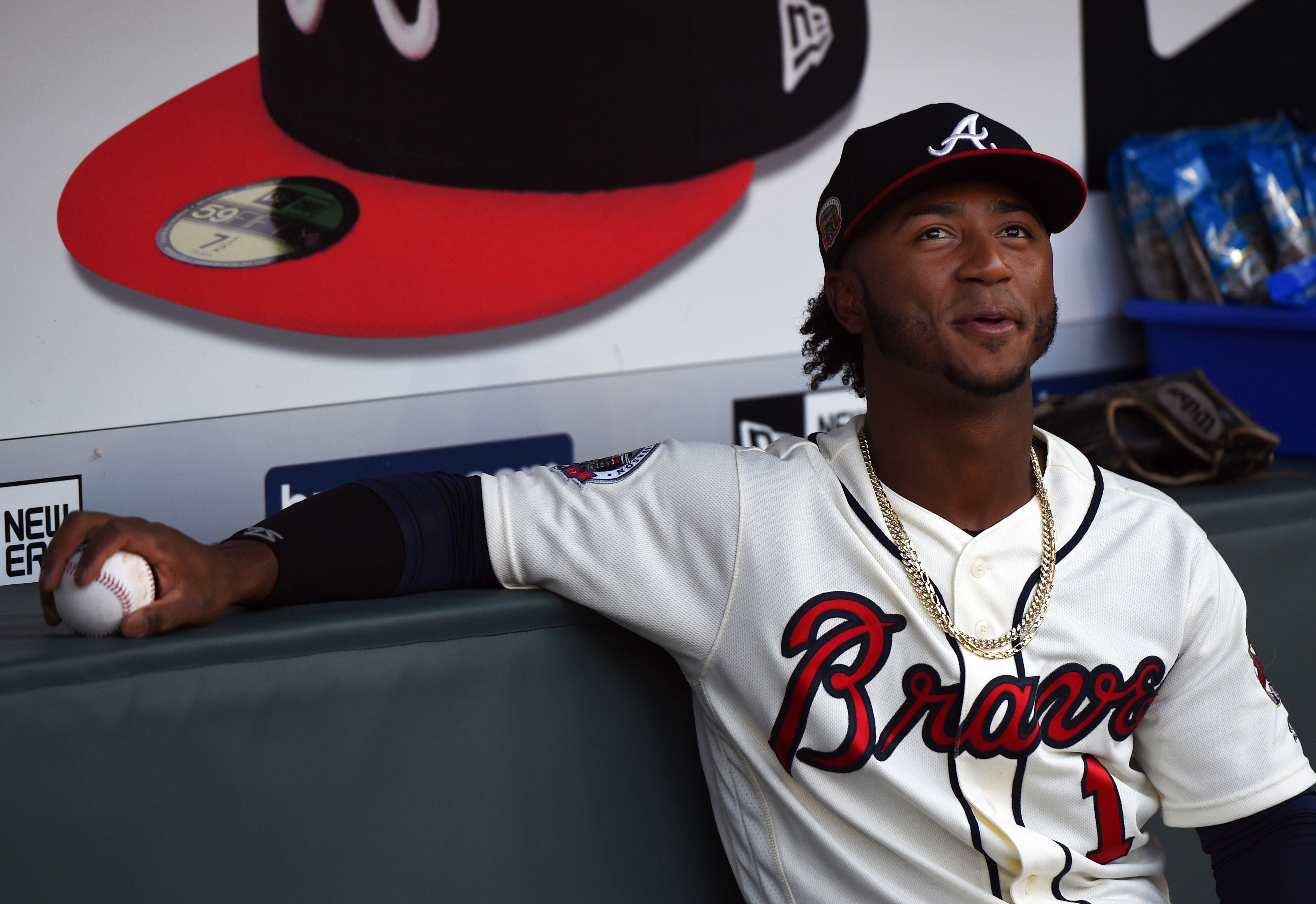
In two short years, the team was nearly completely remade
The 2014-15 offseason had included many trades, which helped stock a farm system in desperate need of talent and depth. However, as far as elite prospects went, Atlanta had mostly struck out in their quest to add more via trades. Mike Foltynewicz and Matt Wisler were the only Top 100-types to join the Braves with Touki Toussaint coming later. The off-season that followed 2015, however, would place the Braves as one of the top minor league systems in baseball.
Before that, though, the team had done a good job adding and developing homegrown talent. Eighteen-year-old Ozhanio Jurdy Jiandro Albies, a switch-hitter out of Curacao, was impressive in a 57-game run during 2014, but took off with Rome in 2015 with a .310 average and 29 steals despite facing pitchers three and four years older than he was. The 2015 draft yielded arms like Kolby Allard, Mike Soroka, and A.J. Minter. Things were coming together in the minors, but they still needed more top-end talent.
John Coppolella, who was promoted to the title of General Manager, was given the reigns and the wunderkind didn’t hold back. In Andrelton Simmons, he had a young defensive star whose bat was slow to come around. Signed to a long-term extension by John Hart in the winter of 2013, Simmons was considered by some a cornerstone to build around. Coppolella did not share that belief. Shortly after the World Series ended, Coppolella traded Simmons to the Angels for three players, including young lefty Sean Newcomb. A month later, he sent Shelby Miller, fresh off a breakout campaign, to the Diamondbacks for Ender Inciarte, young pitcher Aaron Blair, and the 2015 first overall pick, Dansby Swanson.
In Swanson, Coppolella finally had his crown jewel of the remade Braves minor league system. He continued to remake the team, signing Tyler Flowers and taking a flier on Jesse Biddle. He also didn’t care how much Nick Swisher and Michael Bourn were being paid – both were released. In two short years, the team was nearly completely remade with only Freddie Freeman and Julio Teheran remaining from the 2013 roster. The 2016 squard would tie a franchise record with 60 total players used. That record was set the previous season.
The 2016 Braves got off a rotten start, losing their first nine ballgames. After 37 games, they had just nine wins. While the team was not expected to be good, there were limits to the patience the Braves had with that level of play. After losing 8-5 to the Pirates on May 16, Fredi Gonzalez was fired. Gonzalez had withstood a former general manager who he didn’t get along with in Frank Wren and repeatedly was given votes of confidence from his mentor, Bobby Cox. That was not enough to save him, though.
In what became a sadly common theme under Coppolella when it came to baseball decorum, the Braves bungled the firing. After losing to the Pirates, Gonzalez received an email with information about a flight to Atlanta on Tuesday. That was particularly galling because the Braves had just opened a four-game series against the Pirates on Monday. He wasn’t formally told of the decision until the next morning after John Hart joined Coppolella in Pittsburgh to sit down with Gonzalez.
Whether it was coincidence or not, the Braves played better under interim manager, Brian Snitker. A Braves lifer, Snitker’s first managerial job came in 1982 with the Anderson Braves out of Anderson, South Carolina. He was just 26. He joined the major league coaching staff near the end of Bobby Cox’s time in charge. Later, he was managing Gwinnett at the time he was moved up to the major league roster. The Braves won only nine of the first 27 games they played under Snitker, but from June 15 until the end of the season, they finished 50-47 including wins in 20 of their final 30 games. While they still lost 93 games, the improvement was lauded and with reason.
Despite the losing, some players still had special performances. Finally healthy, Freddie Freeman reached a new level in 2016. The 26-year-old hit .302/.400/.569 with a career-high 6.2 fWAR. While some talked up Matt Kemp’s performance after he was acquired from the Padres in the Hector Olivera trade, the truth was that Freeman, who was often labeled a great player, was now an elite hitter.
In addition to Freeman, the Braves found a long-term center fielder after years of looking. Acquired in the Shelby Miller trade, Ender Inciarte hit .291 with a .351 OBP – doing most of his damage in the second half. The Braves searched for nearly a decade to replace Andruw Jones in center field. Mark Kotsay, Jordan Schafer, Nate McLouth, Michael Bourn, Melvin Upton Jr., and Cameron Maybin all had their moments – significantly fewer moments for McLouth and Upton, obviously – but none could take over the position full-time. Inciarte was just getting started, though.
In August, the Braves brought up top prospect Dansby Swanson and traded away Erick Aybar, whose tenure with the Braves was miserable and known more for a chicken bone than results on the field. While the timing of the call-up was confusing as Swanson had barely a year’s worth of minor league action and wasn’t lighting up the world in Double-A, the excitement that Swanson brought to the Braves helped bring fans to the stadium for Turner Field’s final games and had them looking to 2017.
While many fans and media types still questioned the pending move to Cobb County, the stadium to the north was taking shape. The opportunities for fans to engage in business and recreation around the park – something Braves officials mentioned as a justification for the move – was also coming together. The team celebrated the end of Turner Field with a countdown and brought back a number of players and coaches to help close out the park. The stadium, which was modified for baseball after it was an Olympic Stadium for the 1996 games, saw the Braves win ten pennants, a Wild Card, and a spot in the unforgettable (for all the wrong reasons) first Wild Card play-in contest in 2012. The stadium, however, never witnessed a World Series celebration by the home team. Atlanta hoped that would change at the new SunTrust Park.
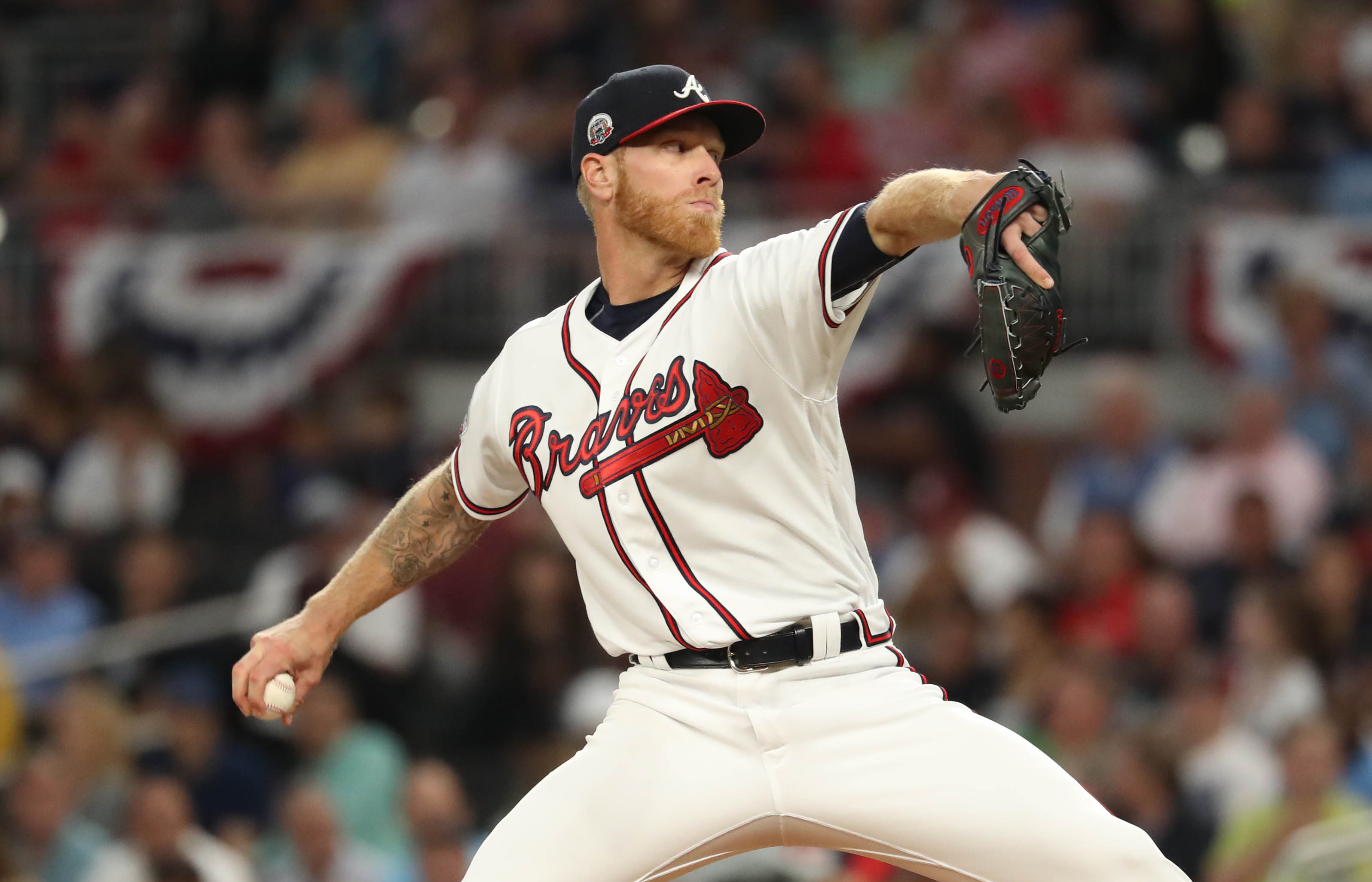
Atlanta was seen by many as a potential sleeper.
As the winter of 2016-17 began, the Braves organization took stock in the team they had. The hope had been that in a quick rebuild, the Braves could compete for a playoff spot by the time SunTrust Park was opened. And the team did have some impressive talent from Freddie Freeman at first to Ender Inciarte in center field and young shortstop Dansby Swanson, who posted an .803 OPS in 38 games the previous summer. The starting staff behind Julio Teheran, however, was a problem. Young guns like Matt Wisler, Aaron Blair, and Mike Foltynewicz had all showed little progression while a revolving fifth starter role provided little hope.
As a result, a choice was made. Atlanta would make minor improvements to buy another year as their young players developed. Essentially, in a year they were opening their new park, the Braves would punt rather than compete. As they added Bartolo Colon and R.A. Dickey, along with trading for Jaime Garcia, it was clear that the Braves would aim to be better, but not try to rush to the front of the line.
And after some early struggles, it looked like their plan was coming together. After finishing a sweep of the Diamondbacks on July 16, the Braves improved to 45-45. They were still 9.5 games behind the Nationals and another six games out of the Wild Card picture, but they were definitely better. However, it all came crashing down from there. They won just three of their remaining 14 games in July.
The normally trade-happy Braves under Coppolella questionably found few takers for their veterans. Why that happened possibly found an explanation at the end of the season. Coppolella, while praised in the media for his outside-the-box thinking, had upset many in the industry through his aggressive communication methods and self-promotion. That, as much as anything, would become his downfall.
2017 was a year of change for the franchise as more-and-more young players pushed veterans out of their way. Brandon Phillips lost his second base job to Ozzie Albies. Adonis Garcia no longer had a job at third base because of Johan Camargo. Southpaws Sean Newcomb, Luiz Gohara, and Max Fried would not be denied more opportunities in the starting rotation while A.J. Minter and Dan Winkler were more reliable than vets like Jason Motte and Rex Brothers. A young team for three years, the level of talent was reaching new heights.
The best of the group, a teenager by the name of Ronald Acuña Jr., didn’t join his organizational mates in Atlanta, but that was by design. Regardless, the young man had a season for the ages in 2017. After beginning the year in Florida, he climbed the ladder to Triple-A showing better walk and strikeout rates as he moved up the system. He blasted 21 homers to go with 31 doubles and 44 steals. He also hit .325. The season had many parallels to another former super prospect, Andruw Jones, who opened 1996 with High-A Myrtle Beach before finishing the year in the World Series. That wouldn’t be Acuña Jr.’s path. The Braves were concerned more with service time than they had been in the mid-90’s. But no one doubted that Acuña Jr. was ready for a taste of the majors.
The Braves lost 90 games in 2017, the third consecutive year they’d reach that total. The offense was a bit better, though the pitching staff struggled – something the veteran pickups did little to help with. Nevertheless, Atlanta was seen by many as a potential sleeper. They were coming. Maybe not in 2018, but soon.
Spoiler alert: The soon was actually in 2018.
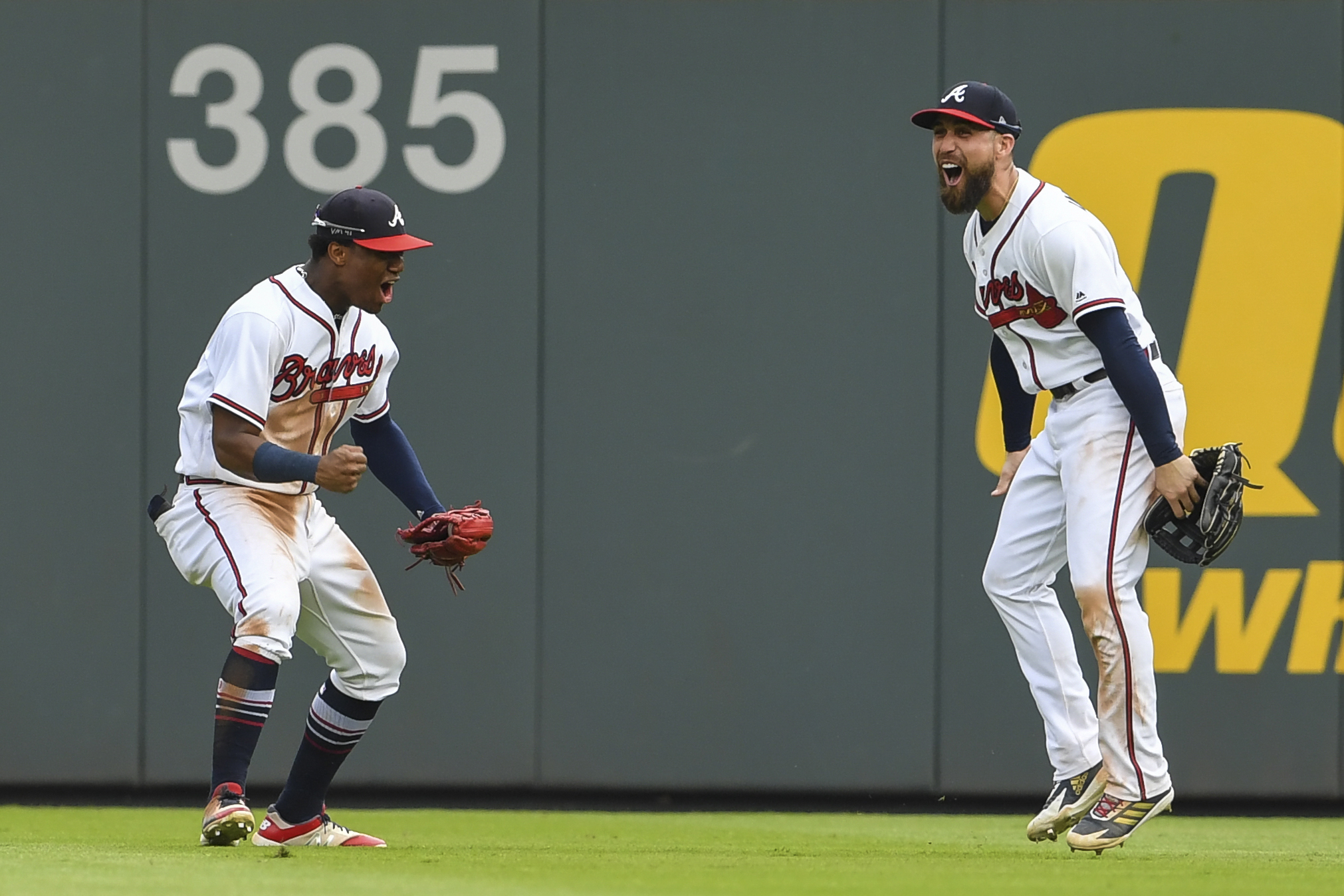
And the Braves never broke
Last winter got off to a rough start as John Coppolella, one of the prime architects of the new Braves, resigned in disgrace. As an exhaustive search later showed, Coppolella had made many under-the-table deals with international prospects in order to sign them and avoid penalties. While many pointed out that what Coppolella did wasn’t really unique to him, the fact was that Coppolella had been either the most egregious offender of the rules or angered enough people in the industry that they let him serve as an example.
In the end, Coppolella was banned from the game and a number of prime prospects he had improperly signed in 2016 were declared free agents by baseball. Those prospects included middle infielders Yunior Severino and Kevin Maitan. The latter remains the record holder for a signing bonus given to an international prospect by the Braves. That doesn’t include any money he may have received under the table.
Certainly not the kind of start to an offseason the Braves wanted after a longer-than-anticipated rebuild. But Atlanta lucked out. One of the criticisms about Coppolella was his ability to build a major league roster. He was accomplished at pooling together young talent, but could he make the final touches on the team to help them move from rebuilding-to-contending? The jury will remain out on that one unless his ban is lifted and he receives a second chance.
But Alex Anthopoulos? We already knew he had that ability. He built a winner from a loser in the always-competitive AL East. Then he went to the Dodgers and learned even more about building a contender. Now, he was given the reigns for a team on the cusp of getting back to their winning ways. He just needed to tweak things and push the right buttons. One of his first concerns was related to the team defense. If the Braves wanted to be a team built around waves of talented, young pitching, they would need to do their part on defense.
The focus on defense wasn’t shared by Anthopoulos’s predecessor either by design or circumstance. Only four other teams had a worse Defensive Runs Saved from 2015-17 than the Braves, who had at least -20 DRS in each season. That could not continue and Anthopoulos pulled out a page from John Schuerholz’s book. When the latter took the job after 1990, he sought to surround his young pitching staff with better defenders like Otis Nixon, Terry Pendleton, and Rafael Belliard. Anthopoulos followed the same blue print, though with a modern twist.
Anthopoulos traded away Matt Kemp, who had been a defensive liability. He also signed Ryan Flaherty and Peter Bourjos, players known for their glove more than their bat. Anthopoulos also listened to his coaches, namely Ron Washington. The latter promised that Dansby Swanson would be much better at shortstop in 2018 than he was in 2017. He was right. In addition, the team was sure to benefit from full seasons from Johan Camargo at third base and Ozzie Albies at second.
But where the Braves truly improved was in their preparation. Where Coppolella talked about analytics, Anthopoulos knew how to utilize them from the bottom of the organization to the top. Even against hitters with zero at-bats professionally, the Braves shifted on them in the rookie leagues. And in the majors, with the availability of a seemingly unending amount of data, Anthopoulos took the lessons he learned from the Dodgers and began to turn the data that required a math degree to understand into usable information for Braves coaches Kevin Seitzer, Walt Weiss, Eric Young Jr., and Ron Washington. Even while beat writers and announcers close to the organization mocked the phrases “exit velocity” and “launch angle” while bemoaning the usage of extreme shifts, Atlanta was embracing it.
Snitker, who had been brought back for another year, still had the ability to learn new tricks even after 40 years in the organization. Before Coppolella’s baseball life ended, the former general manager wanted to get rid of Snitker according to the USA Today’s Bob Nightengale. Much like Fredi Gonzalez before him, a removal of a general manager gave him second life. Would Snitker fair better than Gonzalez? You know that answer.
The new-look Braves opened the season in style as rookie manager Gabe Kapler bungled an opening series. Nick Markakis delivered a walk-off three-run jack on opening day – helping the Braves to a win in a game they were trailing 5-0 against a cruising Aaron Nola before Kapler did Gabe Kapler things. Atlanta closed the series by delivering a 15-2 pummeling as Kapler both failed to warm up a pitcher before bringing him in and was forced into using a position player as a pitcher three games into the year.
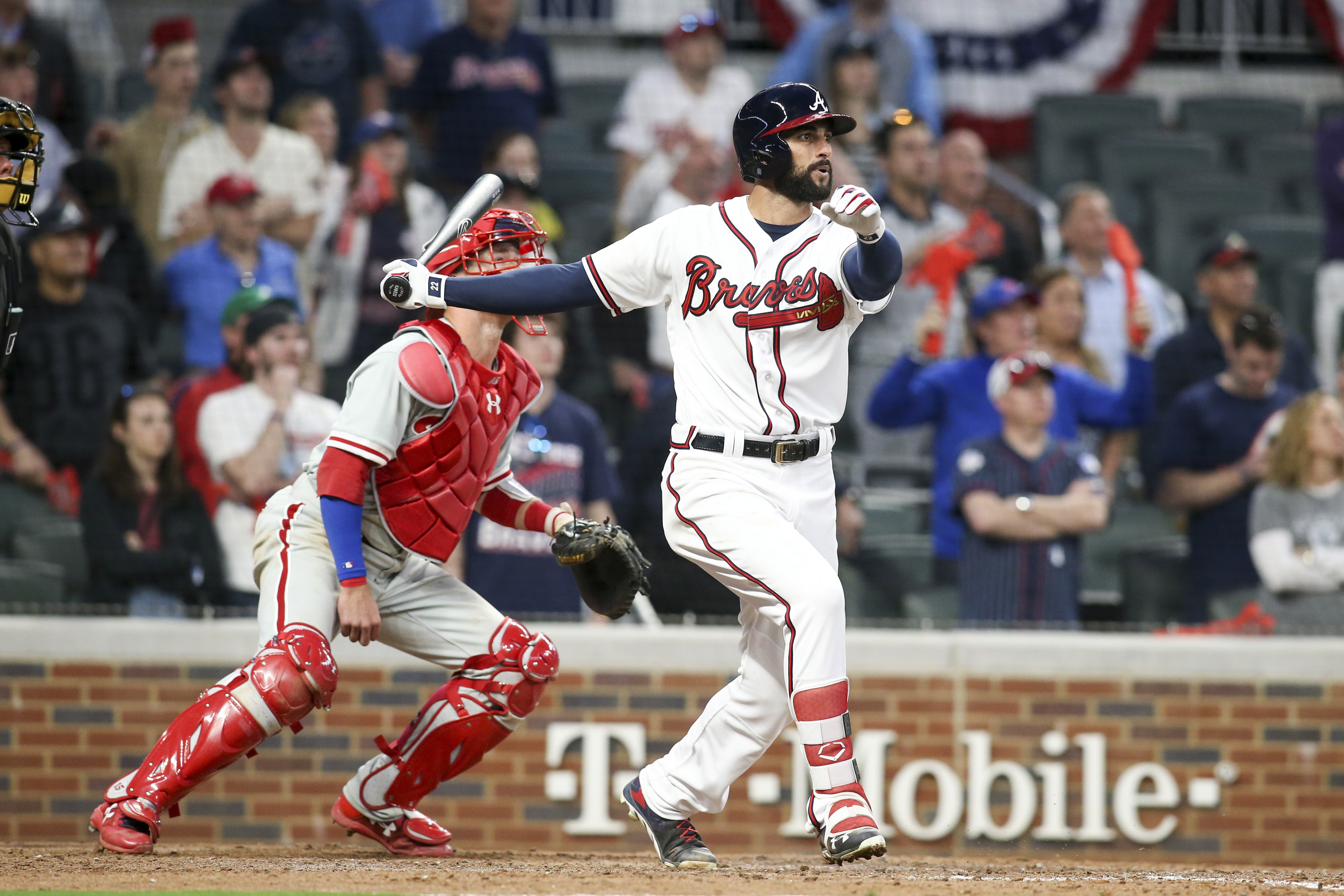
Not a part of the opening week festivities, Ronald Acuña Jr. waited for his turn. The rookie had destroyed spring training pitching, but was demoted near the end of camp as the Braves played the service time manipulation game. Sure, they said he needed more time and Acuña Jr.’s struggles with Gwinnett out of the gate gave them even more validation, but everyone knew the move was about one thing. Keeping Acuña Jr. in the minors for the first few weeks bought the Braves an extra year of team control.
Fortunately for Atlanta, they were getting some production from unlikely sources. Preston Tucker, picked up for nothing from the Astros, delivered several big hits while the glove-first Ryan Flaherty seemed energized to play with his brother-in-law, Markakis. Flaherty battled for the top spot in NL batting average for much of the first month. Both players would fade away, but without their production, Atlanta likely doesn’t finish April with a 16-11 record.
Acuña Jr. was with the team by the end of April. After losses in three-of-four games, including the first two of a four-game series in Cincinnatti, Acuña Jr. was called up on April 25 and delivered a single. The next day, he hit his first homer. The Braves won both games and seven of the first eight games Acuña Jr. played in.
The young do-everything outfielder wasn’t the only top prospect to his chance. Mike Soroka joined the team in May, beating Noah Syndergaard in his first start. Other young arms like Luiz Gohara and Max Fried each got opportunities. The team quickly realized their strength would be completely based on their youth as veterans like Jose Bautista, Peter Bourjos, and Danny Santana quickly wore out their welcomes.
But it wasn’t just the young players who were delivering highlights. In right field, Nick Markakis turned the clock back to his best Orioles days. He was a decent hitter over his first three years in Atlanta, but hit just 24 home runs with a combined fWAR of 3.2. Adjustments at the plate this season led to Hard-Hit rate of 40.4%, roughly 6% higher than his best single season over a decade earlier. With just a few games remaining, Markakis has a chance for his first 3 fWAR season since 2008. The nearly 35-year-old soon-to-be free agent will play in the postseason for just the second time in his career.
The expectation remained that while a nice story, the Braves would begin to fall off. But on May 2, they took over first place in the NL East during a three-game sweep of the Mets and outside of a couple of days in May, they retained the lead through the month. The run included one of the most memorable games in SunTrust Park’s short history.
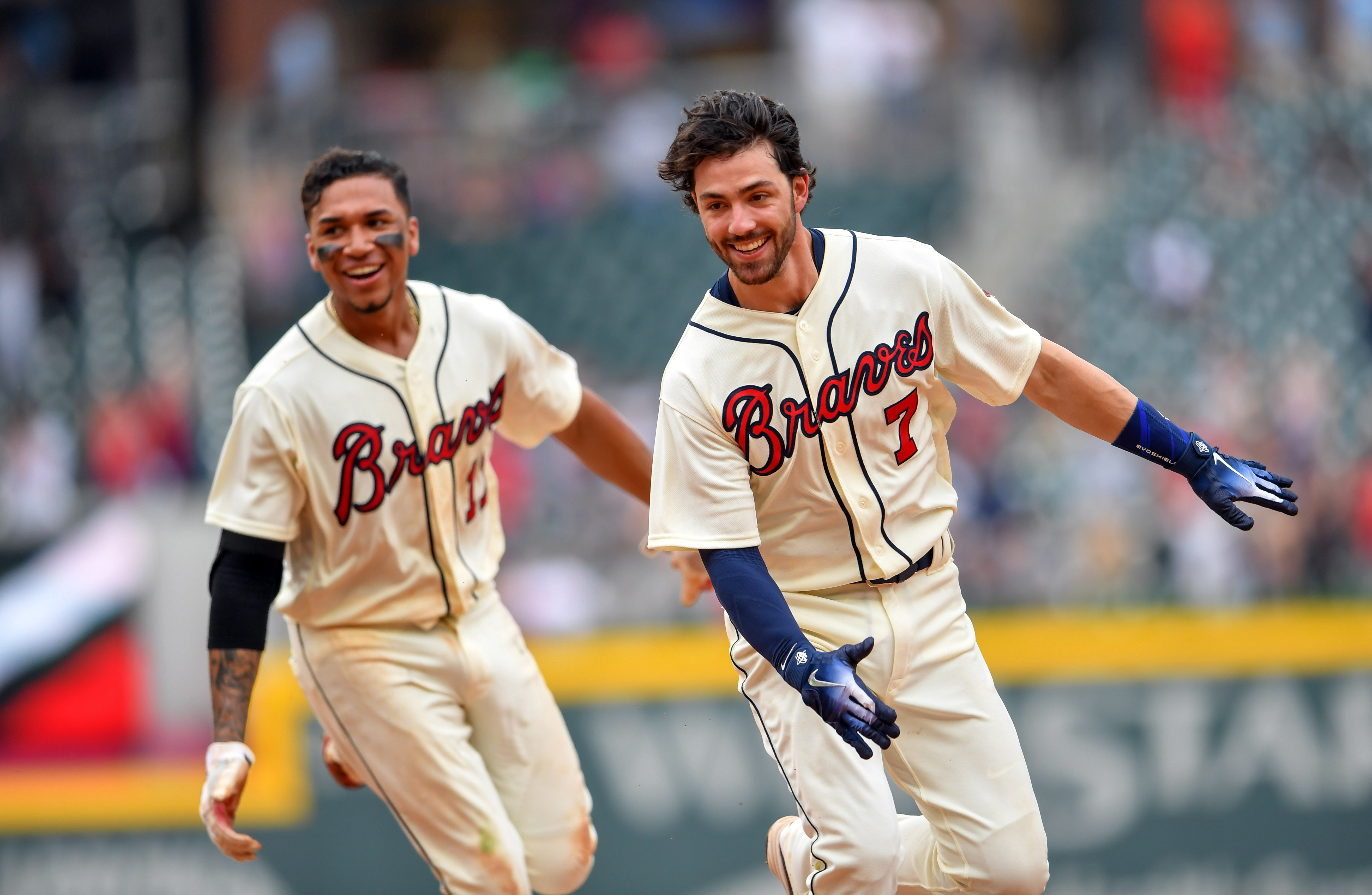
Down 9-4 with one out in the ninth inning, the Braves fought back against the Marlins on May 20. A Flaherty walk and an Albies single started the rally and Acuña brought Flaherty home with a sacrifice fly. However, that meant the Braves only had one out to play with and a four-run deficit. No worries. Back-to-back singles by Freeman and Markakis chased Brad Ziegler and made it 9-7. Tyler Flowers coaxed a walk before Kurt Suzuki, pinch-hitting, delivered a run-scoring single. Down by one, Johan Camargo walked on four straight. That brought Dansby Swanson to the plate. Swanson had struck out to open the frame. Once again down to his last strike, Swanson ripped a single to left and the catching combo of Flowers and Suzuki scored for the walk-off win.
Not everything in May was as good. Atlanta survived a nightmare scenario after Ronald Acuña Jr. hit the ground in Boston in a heap. The initial worries of a torn ACL had Braves Country ready to put any hope of the postseason to bed. Fortunately, Acuña Jr. suffered just a few mild injuries and missed only a month of action.
Two days after Acuña Jr. hit the DL, right-hander Anibal Sanchez returned from a hamstring injury. After being cut in camp by the Twins, Sanchez had been a surprising sign by the Braves. Sanchez looked good in 14 innings of work before hitting a snag running in the outfield in mid-April. Back with the Braves to close out May and armed with a cutter that he developed, Sanchez was a huge find for the Braves after struggling with a 5.67 ERA in the three years before. He was also another coach for the Braves as he helped mold the young pitchers.
As they had done with the Mets to open May, the Braves opened June with a battle for the NL East lead with the Nationals. They actually finished May with a 4-2 win over Washington to put the two teams in a tie. Mike Foltynewicz threw a two-hitter in the second game with 11 K’s to outpitch Stephen Strasburg. After a 14-inning loss the following day, the Ballad of Charlie Clutch was truly born. Charlie Culberson hit a two-run walk-off homer to open the eight-game home-stand. He finished the home-stand with another two-run walk-off bomb. It was the third time during the home-stand that Atlanta “walked it off.” All homers.
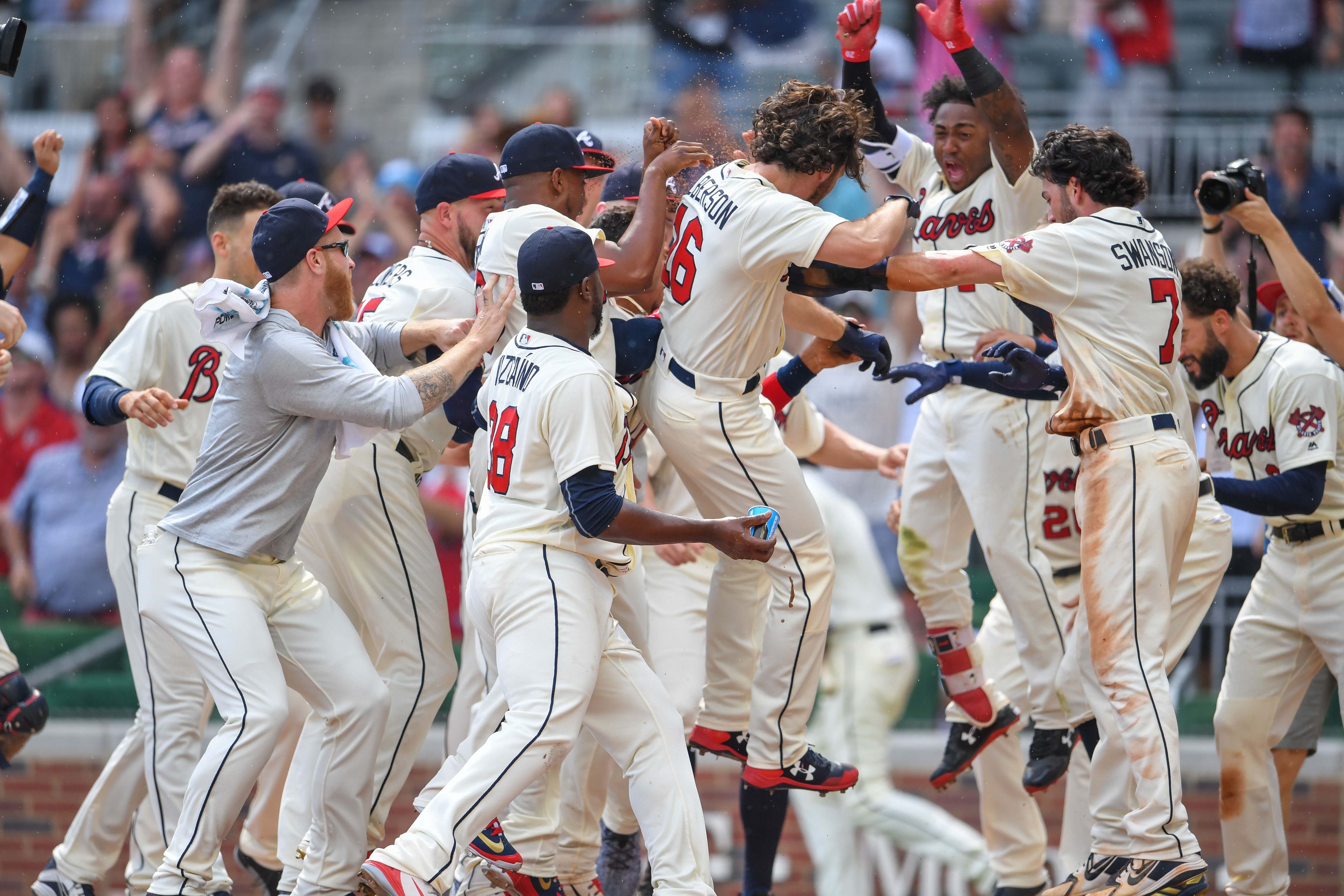
Mike Foltynewicz’s shutout of the Nationals was his first complete game. He would pick up a second before the season was out. For three years, fans and media types alike debated whether “Folty” was better utilized as a starter or reliever. During those years, Foltynewicz often disappeared around the fifth or sixth inning as hitters faced him a third time through the order. But in 2018, Foltynewicz started to figure out how to get them out three times in a game, not just two. Hitters have a .303 OBP against Foltynewicz the third time through the order this season. Last year? It was .360.
As June continued, a tough road trip out west pushed the team back into second place, but home cooking quickly fixed that. As the month came to a close, Atlanta had a three-game lead. July was the month things began to look their bleakest. Against a tough slate of games that included trips to the Bronx, Milwaukee, Washington, and home games against the Dodgers and the (then good) Diamondbacks, Atlanta had their only losing month of the year. But neither the Phillies nor the Nationals could take advantage and while the Braves coughed up a three game lead, they finished the month of July only a half-game out.
Along the way, they added to the team with a quartet of trades at the deadline. They acquired relievers Brad Brach and Jonny Venters for nearly nothing to try to support a leaky pen. With Ender Inciarte struggling, especially against left-handers, they brought in Adam Duvall. Finally, they made a big deal to get Kevin Gausman. These trades continued an approach that Alex Anthopoulos began the previous offseason. Atlanta would add to the team, but would never lose focus on the future. Rather than sign overpriced veterans on the wrong side of 30 to multi-year contracts, Atlanta banked on their youngsters and hoarded them. None of the prospects they traded were considered Top 10 organizational talents.
Another tough slate of games in August followed with trips to Washington and a visit to Pittsburgh, a team riding a hot streak who had paid the hefty price to get Chris Archer – a price the Braves wouldn’t pay. Trips to Atlanta by the Brewers, Rockies, and Rays were also on the docket. Atlanta stayed in second place until August 10. Two days later, they claimed first place once more. No other team would lead the division for the rest of the year. That game, by the way, was started by Touki Toussaint, who shut down the Marlins.
That series was also notable for what happened in the final game of the four-game set. Acuña Jr. was in the midst of a five-game streak with at least a homer in each game. In the first three games of the series against the Marlins, he bashed a homer to open the game. To begin the bottom of the first, José Ureña nailed Acuña with a fastball that smoked the young outfielder in the elbow. The Braves charged the field – led by their manager, Brian Snitker. “He is my kid and I am going to protect him,” Snitker said after the game.
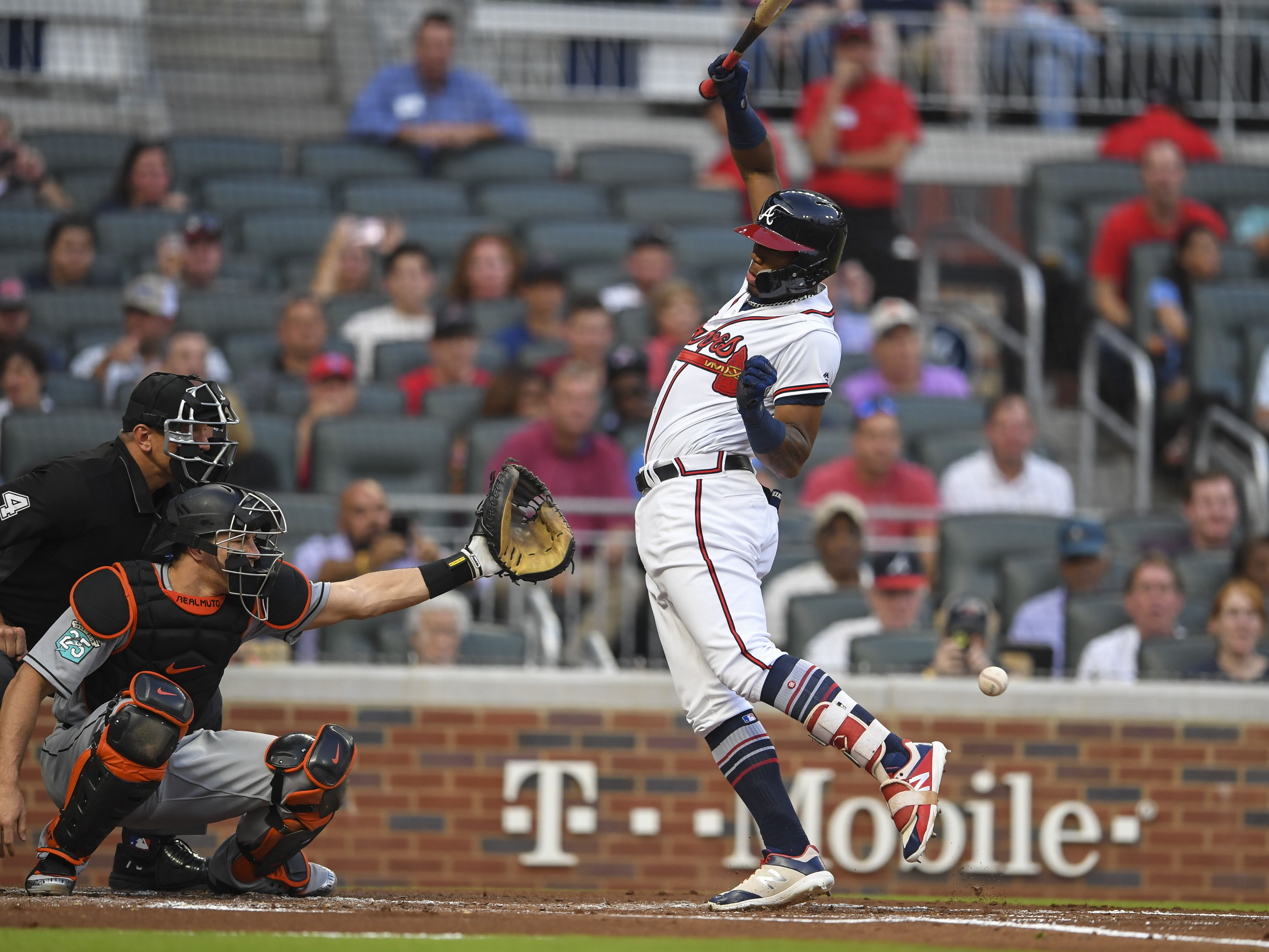
Acuña wouldn’t miss a game and continued to make his case for the Rookie of the Year. And the Braves never broke. From August 22 until the end of the season, their lead fell under three games just twice. New faces came in to help lift up the Braves. Kyle Wright and Bryse Wilson, two of the best starting pitcher prospects in baseball, threw quality frames. Chad Sobotka, who struggled so much the previous year that he was demoted back to A-ball, gave Snitker another fire-throwing arm. Arodys Vizcaino, who missed most of the previous three months, was back on the mound for the Braves by mid-September.
He was the man who took the ball with a 5-3 lead in the ninth inning against the Phillies on a sunny Saturday afternoon. With the count 2-1 and two outs already recorded, Vizcaino got Maikel Franco to hit a lazy fly ball to left field. Waiting on it, quite fittingly, was Acuña.
And the celebration was on.
A series of events that started exactly four years ago with a firing of Frank Wren had culminated in a division title and an invitation to the playoffs. Three consecutive 90-loss seasons tried the patience of fans and front office figures alike. John Coppolella, who was supposed to be the general manager of the good Braves teams we were waiting for, is banned from baseball. This is now Alex Anthopoulos’s team, but be sure that Wren and Coppolella, along with Hart, deserve some credit for this version of the Braves.
They are a hungry team. They have a future MVP in Ronald Acuña Jr, one of the best hitters in baseball in Freddie Freeman, a defense that doesn’t often give other teams second chances, and a pitching staff with so many high-potential arms that on any given day, there could be a no-hitter.
Maybe this team isn’t ready to be a World Series winner yet. Maybe this is not their year for that.
But then, this team wasn’t supposed to make a run at 90 victories either. They weren’t supposed to bury the Nationals. They were supposed to be a year away from even contending for a playoff spot, let alone a spot in the Fall Classic. This team doesn’t care about your projections. They don’t care about what they should be. They only care about what they are and seemingly every day, they get a little bit better. This team is on the cusp of greatness.
This team, man. This team.
Add The Sports Daily to your Google News Feed!
